
WIP Indicates sections that are not completed yet and are due to change.ĭeprecated Indicates sections referring to features that may be removed in a future update and should not be used. There may also be a version number to indicate the lowest version of iOS the section applies to. IOS Indicates the following section or sentence applies only to UTM running on iOS. There may also be a version number to indicate the lowest version of macOS the section applies to. MacOS Indicates the following section or sentence applies only to UTM running on macOS. Throughout the documentation, there will be information that is prepended by labels that are defined below: You can always use the search bar above to quickly find the information you want. We recommend going through the pages in order to learn how to use UTM. The pages are organized in order of most important information to the least important. Check out the links on the left for more information. In short, it allows you to run Windows, Linux, and more on your Mac, iPhone, and iPad. I use a cheap NVMe SSD in a 10Gbps USB-C enclosure-not this exact one, but one like it.UTM is a full featured system emulator and virtual machine host for iOS and macOS. Any external SSD attached over a 5Gbps or 10Gbps USB connection or the Thunderbolt bus should feel fast enough for most things. Mac users with limited internal storage might want to change that to an external drive to save space, since the default disk size for new macOS VMs is 64GB. And more is better, especially if you'll also be running heavy apps like Xcode alongside (or inside) your VM.īy default, VirtualBuddy keeps all of its files (including VM disk images) in a folder at ~/Library/Application Support/VirtualBuddy. Personally, I wouldn't recommend trying to virtualize macOS on an Apple Silicon Mac with less than 16GB of RAM. But you'll be running two entirely separate OSes on the same computer, and that comes with RAM and storage requirements.

VirtualBuddy and the Virtualization framework don't have hard-and-fast requirements aside from requiring an Apple Silicon chip for macOS-on-macOS virtualization. You'll also want to pay attention to the hardware requirements for virtualization. With the Xcode beta installed, everything works as intended (but if you can find a way to get this working without installing a 33GB app that takes an hour-plus to install, I'd love to know about it). When I've tried this without Xcode installed, macOS has tried (and failed) to download extra software to make it work-sort of like how macOS needs to download additional software the first time you use Rosetta. If you're looking to virtualize Ventura on top of Monterey, you'll want to install and run the beta version of Xcode 14 from Apple's developer site before you start. If you want to virtualize macOS Monterey on top of macOS Monterey, you won't have to download anything else.


 0 kommentar(er)
0 kommentar(er)
